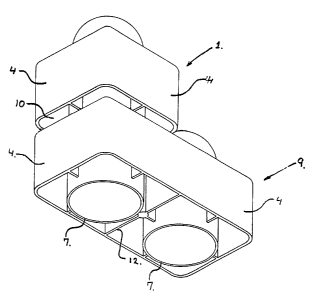Une partie des informations de ce site Web a été fournie par des sources externes. Le gouvernement du Canada n'assume aucune responsabilité concernant la précision, l'actualité ou la fiabilité des informations fournies par les sources externes. Les utilisateurs qui désirent employer cette information devraient consulter directement la source des informations. Le contenu fourni par les sources externes n'est pas assujetti aux exigences sur les langues officielles, la protection des renseignements personnels et l'accessibilité.
L'apparition de différences dans le texte et l'image des Revendications et de l'Abrégé dépend du moment auquel le document est publié. Les textes des Revendications et de l'Abrégé sont affichés :
| (12) Brevet: | (11) CA 2200331 |
|---|---|
| (54) Titre français: | JEU DE CUBES EMPILABLES |
| (54) Titre anglais: | A STACKABLE BLOCK SYSTEM |
| Statut: | Réputé périmé |
| (51) Classification internationale des brevets (CIB): |
|
|---|---|
| (72) Inventeurs : |
|
| (73) Titulaires : |
|
| (71) Demandeurs : |
|
| (74) Agent: | FETHERSTONHAUGH & CO. |
| (74) Co-agent: | |
| (45) Délivré: | 2005-05-03 |
| (86) Date de dépôt PCT: | 1995-09-28 |
| (87) Mise à la disponibilité du public: | 1996-04-04 |
| Requête d'examen: | 2002-08-08 |
| Licence disponible: | S.O. |
| (25) Langue des documents déposés: | Anglais |
| Traité de coopération en matière de brevets (PCT): | Oui |
|---|---|
| (86) Numéro de la demande PCT: | PCT/DK1995/000389 |
| (87) Numéro de publication internationale PCT: | WO1996/009870 |
| (85) Entrée nationale: | 1997-03-18 |
| (30) Données de priorité de la demande: | ||||||
|---|---|---|---|---|---|---|
|
Le jeu de cubes empilables de la présente invention est constitué de cubes empilables comportant un corps présentant sur sa face supérieure des pions d'assemblage caractérisés par un écartement modulaire mutuel uniforme. Le corps de cube présente en outre, des structures d'assemblage orientées vers le bas, lesquelles structures d'assemblage sont complémentaires des pions d'assemblage de la face supérieure, et sont conçues pour s'assembler avec les pions d'assemblage. Selon la présente invention, les cubes comportent en complément une ou plusieurs cales de butée orientées vers le bas. Grâce à ces cales de butée, lorsque deux cubes empilables sont empilés l'un sur l'autre, les parties constituant le corps des cubes empilables restent séparées l'une de l'autre sur l'ensemble de leur périmètre. On dispose ainsi d'un bord de préhension ou d'un intervalle entre les deux cubes empilés l'un sur l'autre, ce qui facilite particulièrement la préhension des cubes pour désassembler les cubes d'une pile.
A stacking block system having stacking
blocks which have a body part which is
provided with coupling knobs with a mutual
uniform modular distance on its upper
side and is downwardly provided with coupling
means which are complementary with
respect to the coupling knobs on the upper
side and are adapted to be coupled with the
coupling knobs. According to the invention,
the blocks are additionally provided with one
or more spacers downwardly, which are designed
such that when two stacking blocks
are stacked on top of each other, the body
parts of the stacking blocks will be spaced
from each other along their entire periphery.
This provides a gripping edge or a gap
between two blocks stacked on top of each
other, so that it is particularly easy to grip
the blocks when a stack of such blocks is to
be separated.
Note : Les revendications sont présentées dans la langue officielle dans laquelle elles ont été soumises.
Note : Les descriptions sont présentées dans la langue officielle dans laquelle elles ont été soumises.

Pour une meilleure compréhension de l'état de la demande ou brevet qui figure sur cette page, la rubrique Mise en garde , et les descriptions de Brevet , États administratifs , Taxes périodiques et Historique des paiements devraient être consultées.
| Titre | Date |
|---|---|
| Date de délivrance prévu | 2005-05-03 |
| (86) Date de dépôt PCT | 1995-09-28 |
| (87) Date de publication PCT | 1996-04-04 |
| (85) Entrée nationale | 1997-03-18 |
| Requête d'examen | 2002-08-08 |
| (45) Délivré | 2005-05-03 |
| Réputé périmé | 2007-09-28 |
Il n'y a pas d'historique d'abandonnement
| Type de taxes | Anniversaire | Échéance | Montant payé | Date payée |
|---|---|---|---|---|
| Le dépôt d'une demande de brevet | 300,00 $ | 1997-03-18 | ||
| Enregistrement de documents | 100,00 $ | 1997-04-14 | ||
| Taxe de maintien en état - Demande - nouvelle loi | 2 | 1997-09-29 | 100,00 $ | 1997-07-28 |
| Taxe de maintien en état - Demande - nouvelle loi | 3 | 1998-09-28 | 100,00 $ | 1998-09-10 |
| Taxe de maintien en état - Demande - nouvelle loi | 4 | 1999-09-28 | 100,00 $ | 1999-09-10 |
| Taxe de maintien en état - Demande - nouvelle loi | 5 | 2000-09-28 | 150,00 $ | 2000-08-17 |
| Taxe de maintien en état - Demande - nouvelle loi | 6 | 2001-09-28 | 150,00 $ | 2001-08-03 |
| Taxe de maintien en état - Demande - nouvelle loi | 7 | 2002-09-30 | 150,00 $ | 2002-08-06 |
| Requête d'examen | 400,00 $ | 2002-08-08 | ||
| Taxe de maintien en état - Demande - nouvelle loi | 8 | 2003-09-29 | 150,00 $ | 2003-08-07 |
| Taxe de maintien en état - Demande - nouvelle loi | 9 | 2004-09-28 | 200,00 $ | 2004-08-05 |
| Taxe finale | 300,00 $ | 2005-02-16 | ||
| Taxe de maintien en état - brevet - nouvelle loi | 10 | 2005-09-28 | 250,00 $ | 2005-08-05 |
Les titulaires actuels et antérieures au dossier sont affichés en ordre alphabétique.
| Titulaires actuels au dossier |
|---|
| INTERLEGO AG |
| Titulaires antérieures au dossier |
|---|
| FREDERIKSEN, JESPER BO |